Does your provider understand you?
When seeking an organization to support your digital learning options, it can be easy to get caught up in the details of content, technology, and instruction. Don't get us wrong — these are all important! But, we find that most K-12 schools eventually start wondering, "which of these providers understands ME?"
Choosing the right provider means thinking about who understands you, your schools, programs, teachers, and students. In this white paper, we break down what this looks like, and what kinds of questions to ask your provider(s).
Step 1: Analyze the Instructional modalities
We start by looking at instructional modalities in K-12, then explore the ways in which they show up in various districts. Here are the instructional modalities we typically see:
- Fully online schools
- Hybrid schools
- Traditional schools with blended learning
We realize that you may not fit neatly into any of the above models. In some cases, schools or districts may cross boundaries or be in a unique category altogether. Let’s take a moment to break down each model.
Fully online schools
Let’s say you’re running a school with K-12 students who are fully online. Critics often talk about what online schools don’t have to do because everything is digital, but you wish they understood that they’re missing something extremely important: you must serve the full range of K-12 students, including all of their potential needs (i.e. accelerated learning, IEPs, etc.). With the exception of school meals and transportation, you are responsible for providing all of the same instructional and support elements that they would receive if they were in a traditional school — and you have to do it from a distance.
That’s not easy.
Adding on to that pressure is the perception resulting from what we saw during the pandemic. Many people now equate online learning with emergency-remote learning. We know that these two models aren’t the same, and we also understand that schools spend considerable time and effort to find, train, and support teachers; support students; and work with families. Take a look at the following chart, comparing each of the learning models.
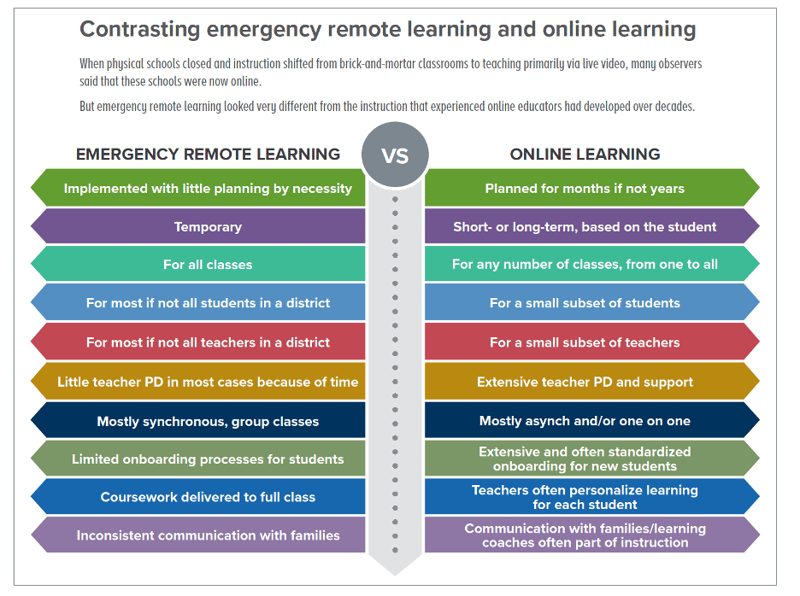
Source: Digital Learning Collaborative, 2022 Digital Learning Snapshot
Based on our research and experience, we know that most K-12 online schools primarily utilize asynchronous instruction, which means teachers must have first-rate technology to communicate with students and families. Many online schools are increasingly using real-time video in creative ways to bolster instruction.
Even with videos and different instruction methods, student engagement is still a primary concern for online schools. We can’t solve that problem entirely, but we can help by providing tools and new ideas for strengthening communications and immersing students in their learning. For example, we know that successful online schools stress connecting with students before there’s an engagement problem, such as with a virtual “meet the teacher” or “digital profiles” to help the class get to know one another.
The fact is, K-12 online schools have existed for more than two decades. Your provider should understand that every school is unique, and should adapt to fit your local context.
Hybrid Schools
Hybrid schools combine online instruction with onsite teaching and learning. This combination unlocks the potential strengths of both online and traditional learning, and it can look very different from one school to another. But, that doesn’t make it easy.
Without appropriate planning and implementation, schools may arrive at a less than optimal mix of onsite and online learning. Schools must balance a variety of elements, including time, space, content, technology, and relationships to provide an experience where K-12 students thrive.
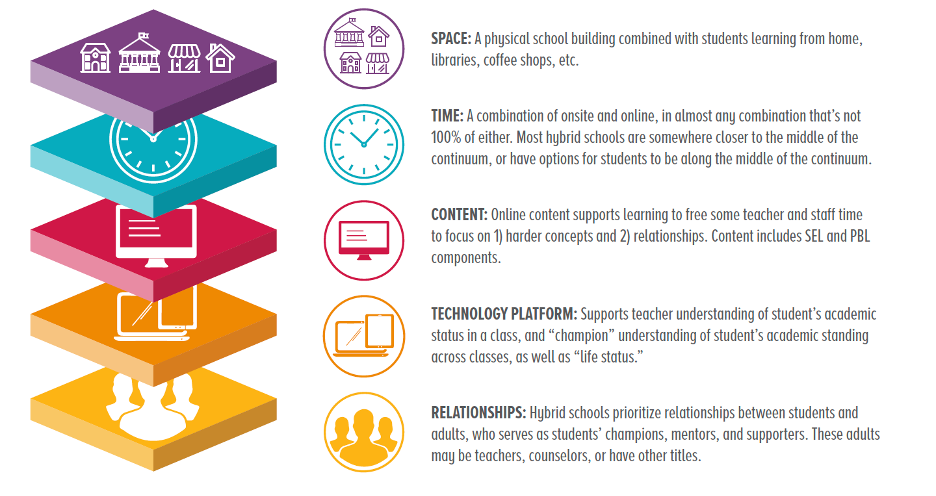
Developing an adequate schedule is often the first step in addressing these elements — and it’s often the number one aspect of hybrid schooling we’re asked about. Take a look at the following sample K-5 schedule from Poudre Global Academy in Colorado:
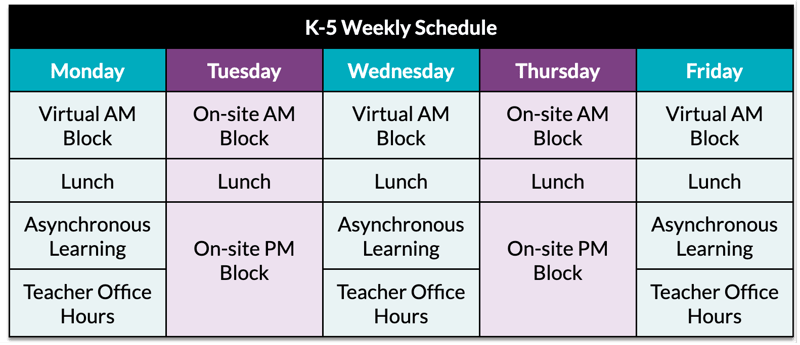
The above school schedule varies for grades 6-8 and grades 9-12, depending on the needs of students, and offers new opportunities for teachers to engage with their learners. Different hybrid schools may opt for different schedules. Valor Preparatory Academy of Arizona has a similar schedule, but utilizes StrongMind digital curriculum to provide continuity between the online and in-person experiences.
Dan Mahlandt, principal at Valor, says that “When our students are remote, they benefit from a strong digital curriculum and reliable LMS that connects them with teachers and lets them engage with content in meaningful ways. That means that we can be highly intentional about what students and teachers focus on when they’re in our building. For some students, this means personalized one-on-one or small group instruction; for others, this means unique project-based learning to foster particular skills or interests.”
StrongMind currently supports hybrid schools in both Arizona and Ohio. To build out these hybrid programs, we first studied models in California, Colorado, North Carolina, and other states. Our research and our experience working with real hybrid schools allows us to better understand the needs and challenges school or districts may be looking to address with new or existing hybrid programs
Traditional Schools with Blended Learning
The first two models describe different ways that school districts and charter schools use time and space creatively. While online and hybrid learning are great options for a wide variety of students, the bottom line is that the large majority of learners are still attending a traditional brick-and-mortar school —and that’s OK!
Even in traditional schools, administrators and teachers often deploy digital content and technology to support K-12 learning. Often called blended learning, digital tools (such as full curriculums or other supplemental programs) helps teachers personalize instruction. StrongMind, for example, focuses on two elements to do this:
- Standards digital content that can be deployed in flexible ways to engage students
- Real-time data gives teachers key insights to student performance
We find that the most successful districts often look at digital learning options in traditional schools as a continuum of student and teacher options.
Some teachers may use a few online modules to augment instructional materials, or to replace textbooks completely. Others may assign lessons for group or independent work. Their approach may differ by class or by school, perhaps with elective courses relying entirely on digital content and core courses combining online resources and textbooks.
Schools are not the only ones with a shifting view on the relationship between technology and learning. Students are increasingly viewing online and traditional learning as options they can mix and match. Millions are already enrolled in a physical school while also taking one or two online courses. For some, this may free up time in their schedule or help them get ahead. Students opt for flexible learning for a number of reasons.
Other students recognize that whether they are going into college or a career, there is a good chance that they will need to learn online at some point. More and more college students are taking online courses every year, and much of corporate training has already moved online. The skills and mindsets that students can learn by taking an online course in high school will serve them well in their post-high school trajectory.
Almost all districts offer some online content or courses, but are they maximizing their options and doing so most efficiently?
Ask your provider if they have the flexibility and toolset to support schools in tying new and existing resources together so you can offer an effective and efficient solution that lets students, teachers, and families thrive.
Step 2: Analyze the Program Types
Whether a school opts for online, hybrid, or blended instruction, they’re often also looking to fulfill the needs for specific program types. These are some of the most common ones we see:
- Credit recovery
- Alternative education
- Independent study
- Intermediate units
Credit Recovery
Helping students who have fallen behind on credits is probably the most common use of digital learning — but that doesn’t mean these programs are easy to design and implement. Schools must think about how to work with students, who may need credit recovery simply because they found a particular class challenging, or perhaps because of external reasons such as health concerns which led to truancy.
There’s a good chance that you already have a credit recovery program in place, but is it meeting your needs, and your students’ needs? These are some of the things schools who already have credit recovery programs or who are trying to implement one look for:
- High-quality, engaging content
- A way to accelerate the learning but still hold students accountable for mastering course content and standards
- A technology platform that gives real-time data and progress monitoring
- Flexibility for teachers and staff to provide individualized learning
In some cases, you may be trying to implement or work in a credit recovery program that functions at the district level, spanning across multiple schools. This raises a unique set of challenges, such as continuity across grade levels and schools.
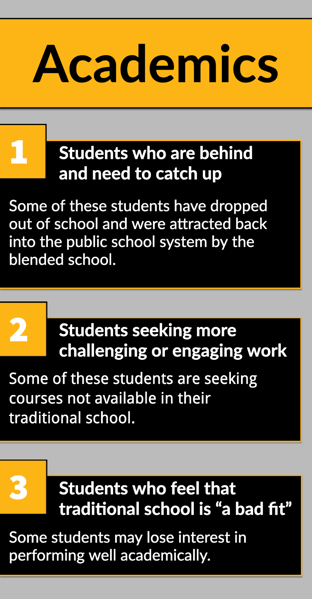
Adapted from: Foundation for Blended and Online Learning. 2016. Why do students choose blended and online schools? Evergreen Education Group. https://files.eric.ed.gov/fulltext/ED589983.pdf
Alternative Education
Your district may be among the many that have developed an alternative education option for students who have not fared well in traditional schools. Offering an alternative school or campus is often a next step to operationalize work with at-risk students. These students need to recover credits and often need to earn new credits quickly because they are at risk of aging out of the system. They also may be facing challenges related to attendance, mental or physical health, pregnancy or parenting, or other issues.
These students often want time flexibility, but they also need support in the form of mentor relationships and one-on-one academic tutoring.
This is where many hybrid programs excel. They understand that students gain time flexibility from taking online courses, and that the on-site space provides a place for face-to-face, personalized support. These programs prioritize relationships by systematizing support roles. They place caring adults in roles as mentors or student champions. These adults may be teachers, or counselors; or they may have other titles.
The alternative program is designed to make sure that someone is responsible for the whole student. “Hybrid” can sound a bit technical, but in practice it often manifests as the exact opposite — as a flexible type of instruction that brings out the interests and passions each student has, leading to a new level of engagement.

Adapted from: Foundation for Blended and Online Learning. 2016. Why do students choose blended and online schools? Evergreen Education Group. https://files.eric.ed.gov/fulltext/ED589983.pdf
Independent Study
In some ways, independent study is a California-specific version of alternative education. In other ways, this program is a concept that unlocks new student potential.
This may be because “independent study” is somewhat misnamed. Yes, it’s independent in the sense that students have lots of time flexibility. The best independent study programs find that when they pair this flexibility with strong adult support, this combination can unleash agency in students who now feel in control of their learning for the first time.
The “strong adult support” is key, which is why the terms “independent study” can be misleading. “Independent” means that the student is in control; it doesn’t mean that they are learning alone. In fact, the best independent study programs take the same approaches that we describe among hybrid schools; they combine the best elements of online learning with the best support elements of interacting one-on-one with a caring adult.
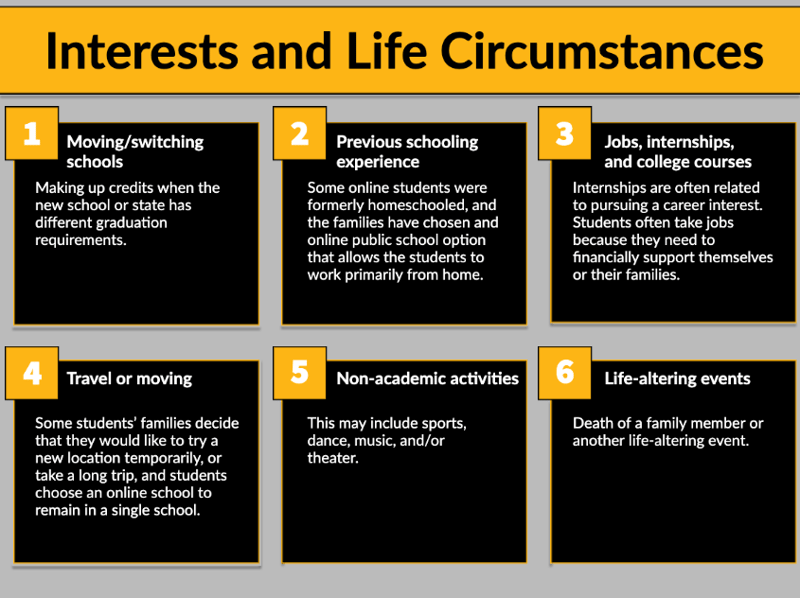
Adapted from: Foundation for Blended and Online Learning. 2016. Why do students choose blended and online schools? Evergreen Education Group. https://files.eric.ed.gov/fulltext/ED589983.pdf
BOCES, County Offices of Education, Service Centers, and other Intermediate Units
An often-overlooked fact is that intermediate units play a critical — and increasing — role in deploying new opportunities for students. The U.S. has more than 13,000 school districts. Many of these schools are large enough to run their own alternative education, independent study, or credit recovery programs. However, many districts (especially rural) are quite small, and so seek help from regional service agencies.
If you’re such an agency, you know that you have a distinct role in serving districts seeking to support their students with innovative learning options, but don’t yet have the resources and expertise to provide those options alone.
You may be serving a dozen districts — and perhaps more than that — each with distinct needs and interests. In these cases, flexibility is the key, and both your curriculum and technology should support this.
Step 3: Craft a Solution
StrongMind understands that approaches to digital learning vary. We’re here to help you achieve your vision, whether you know that vision now or you want help creating it.
This white paper has explored a variety of different instructional modalities and program types. We don’t pretend to know what is best for your local context, but we can build on our experience to help you consider your ideal options.
Based on these core beliefs, ask providers the following:
- Do students come first?
- Are teachers central to planning and implementation?
- Is your content standards-based and high quality?
- Is your technology platform easy to use and responsive?
- Different grade levels have different needs. How does your content and technology differentiate for, say, elementary students and high schoolers?
